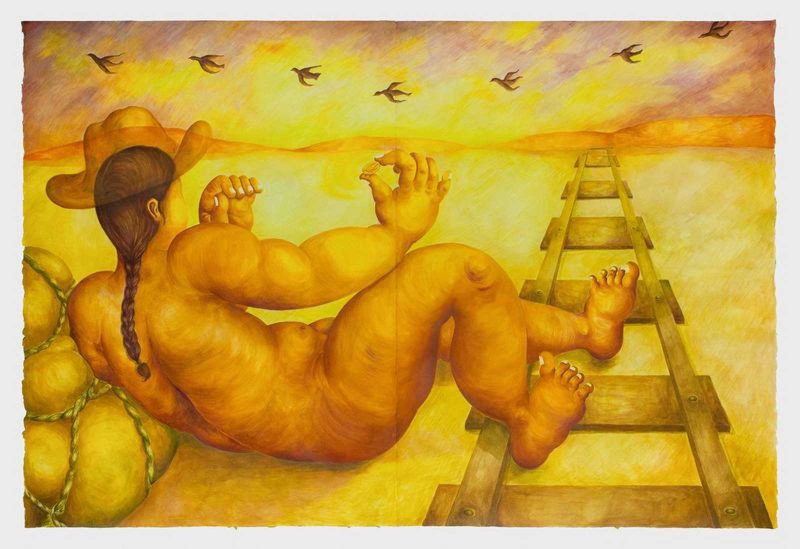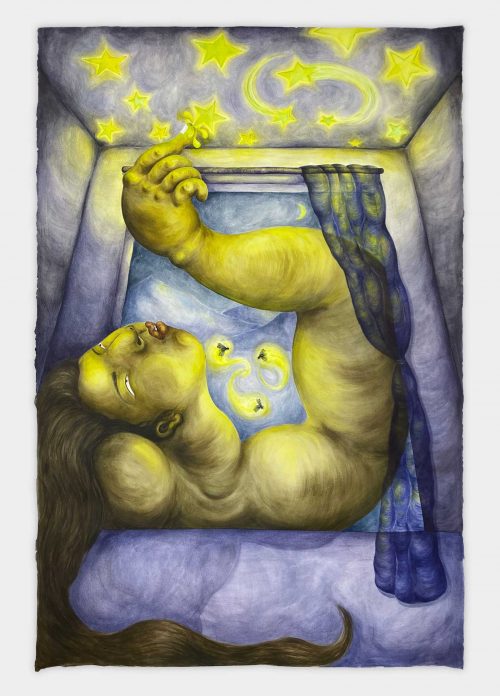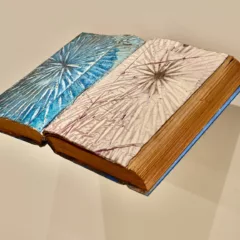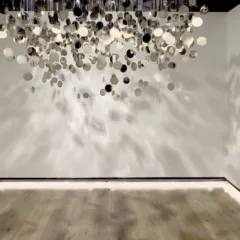
Lately a lot of media would have us think we’ve been dealt plenty of solitude, but our confinement is mostly convoluted. There are too many intrusions, too many responsibilities relegated to the home. Relaxing moments are plagued with rememberings of work things to check on; there’s children, family and/or housemates to accommodate; we’ve got endless guilt around “productivity” (internalized capitalism), the list goes on. These pangs of a world shrunken down to a personalized size rarely leave room for reflections, and we’re left in various forms of resentment.
I Wasn’t There is Lily Wong‘s new solo exhibition at Kapp Kapp Gallery, two rooms full of acrylic paintings predominantly done on paper of varying sizes. In the show, many of Wong’s colorful, chubby, and naked characters seem resentful or uneasy in their solitudes, much like the moment we’re experiencing back in our world. The variously yellow-shaded (read: East Asian) subjects are often mid-moment in ways not easily defined, though they all still carry narratives. Some of these stories are grounded in real life, while others show more fantastic scenes.
Take “Minor Feelings,” a dreamy illustration. The figure is reclined, their head, shoulders and an arm coming in through a window to poke lit-up ceiling stars, bleeding a yellow that matches the decorations’ glow. Their hair is down, drooping to the floor of the painting. Cyclical brush strokes bloat limbs into exaggerated yet proportional sizes, warping the painting into a sense of living motion. The image suggests the person is floating, laid backwards into a room, poking at childish things. In spite of this playful, unreal setup, the figure’s face isn’t happy. They’re absorbed in wherever their mind is, there but not there. At least four other paintings are also in or allude to the bedroom, fantasies attempting relaxations they can’t quite reach. Insects — in small groups and here, spinning like lit-up fireflies — accompany Wong’s women, spectating and interacting with their solitudes within the grouped images.

On the flipside of being watched by creatures is “Contact,” a relaxing view of a desert landscape, one of the largest pieces of the show. Next to a railroad track, a person reclines on a pile of what might either be stones or belongings tied up tightly with rope, facing away at a twilit sunset, presumably after a day of work. With a gold coin (a day’s pay) in hand, they watch birds soar in the beautiful evening. Instead of adding to the timeless worlds of beds and dream-states, “Contact,” as well as few other pieces in the gallery, frame imagined moments contributing to a historical truth. Asians were most definitely helping build up the west coast, and Wong’s small thematic series within the show aims to represent this via ten gallon hats, excessively worked cowboy boots, transparent saloon doors, and ropey rugs within rustic locations. These scenes feed into the recent wave of artists recontextualizing the role people of color played in building the American West, an exciting and ongoing rebuttal of the whitewashing many of us were raised to believe.
While most of these pictures give some idea of a setting, a few are without. Interestingly, these vaguenesses are where the most interaction occurs. A goose perches in the hair of a hidden face, a moth morphs the likeness of another. An unexpected COVID-19 piece shows an annoyed-looking woman flashing the viewer her vaccination card, maybe at someone being racist.
The majority of the visuals involve nudes, but the work isn’t especially sexual. The nudity gives more of a sense of vulnerability. Figures are stripped and lost in thought whether the interaction is with living things (plants, landscapes, animals/insects) or themselves. A few are guarded in their stances, set up in ways that almost interact with and resent the viewer for intruding. I think the nudity also lends itself to Wong’s use of color, with various skin tones (yellows with orange, brown, red and green tints) complementing vibrant scenes.
Overall, there are strong dualities here — between the self and society, between dreams and histories, between created and natural things. If you have the time, and feel confident enough to make the trip to center city Philadelphia, I Wasn’t There is a great space for reflection on these things.
You can reserve a viewing time online, or just walk by on the street! The windows of Kapp Kapp are large enough for you to see nearly the whole thing from outside, if you’re still hesitant to be in an enclosed space.
“I Wasn’t There” by Lily Wong is on view @ Kapp Kapp Gallery from April 9 — May 29, 2021.









